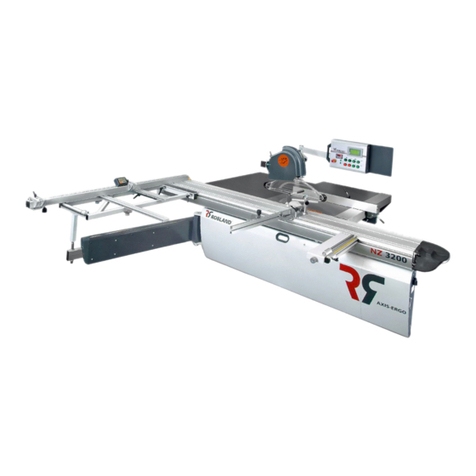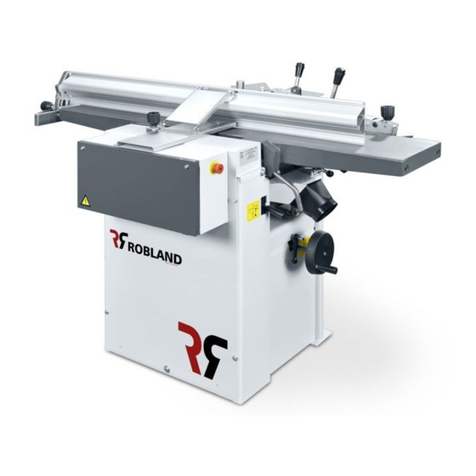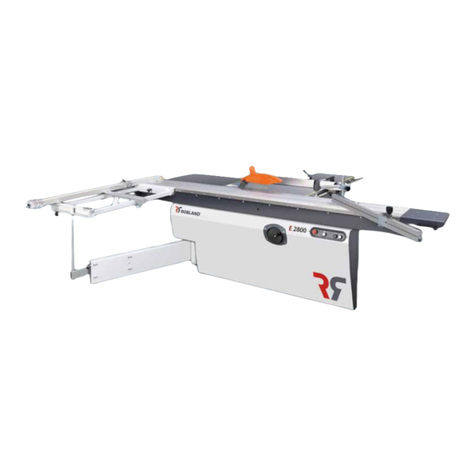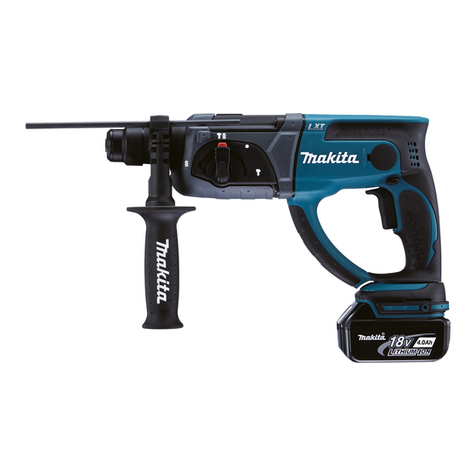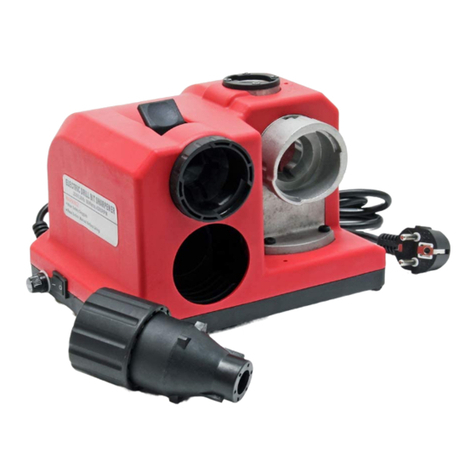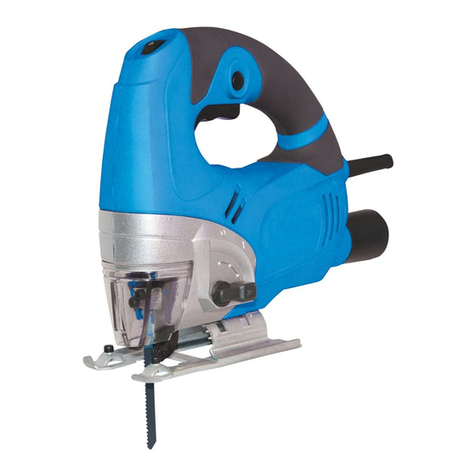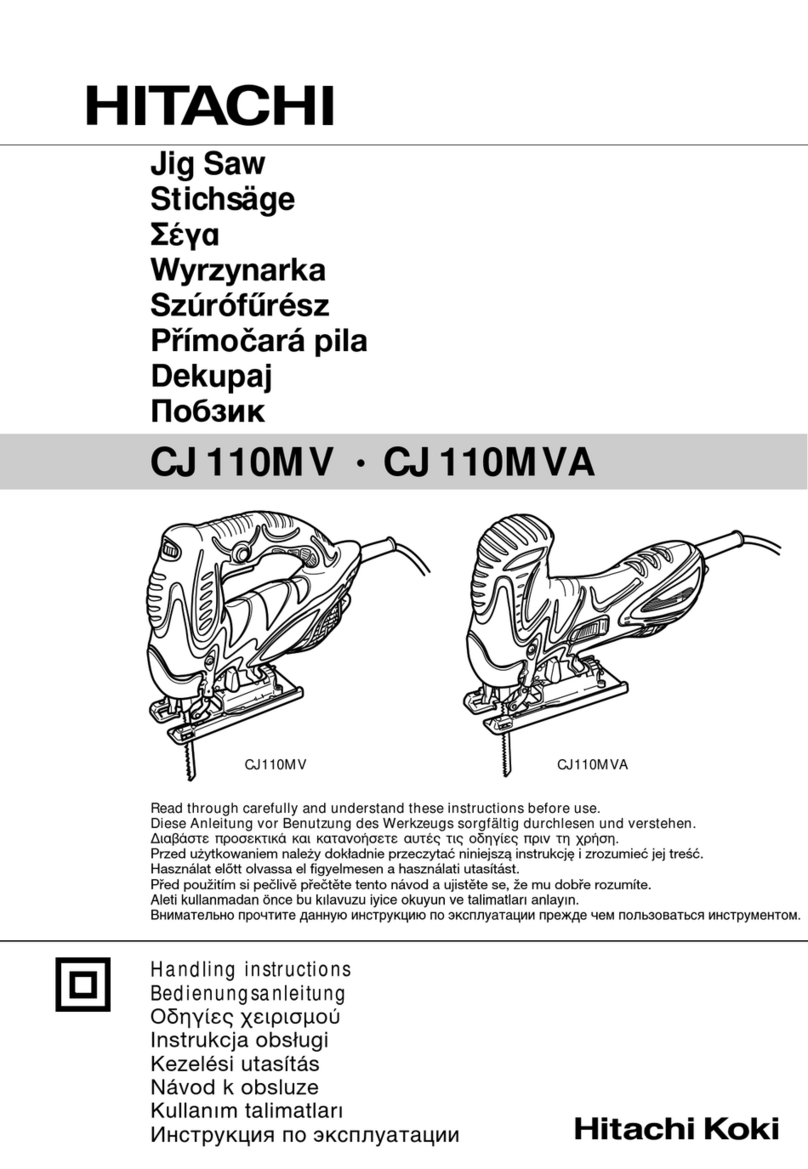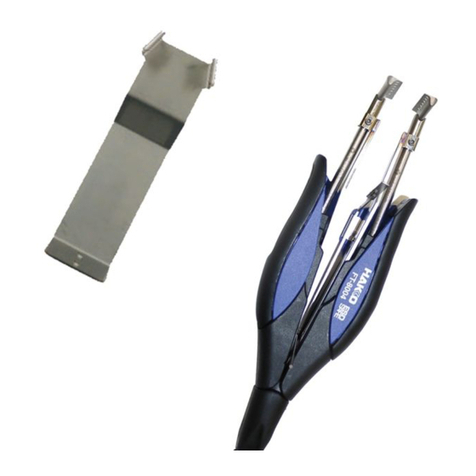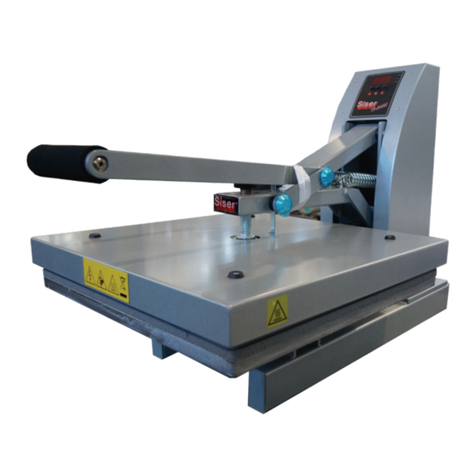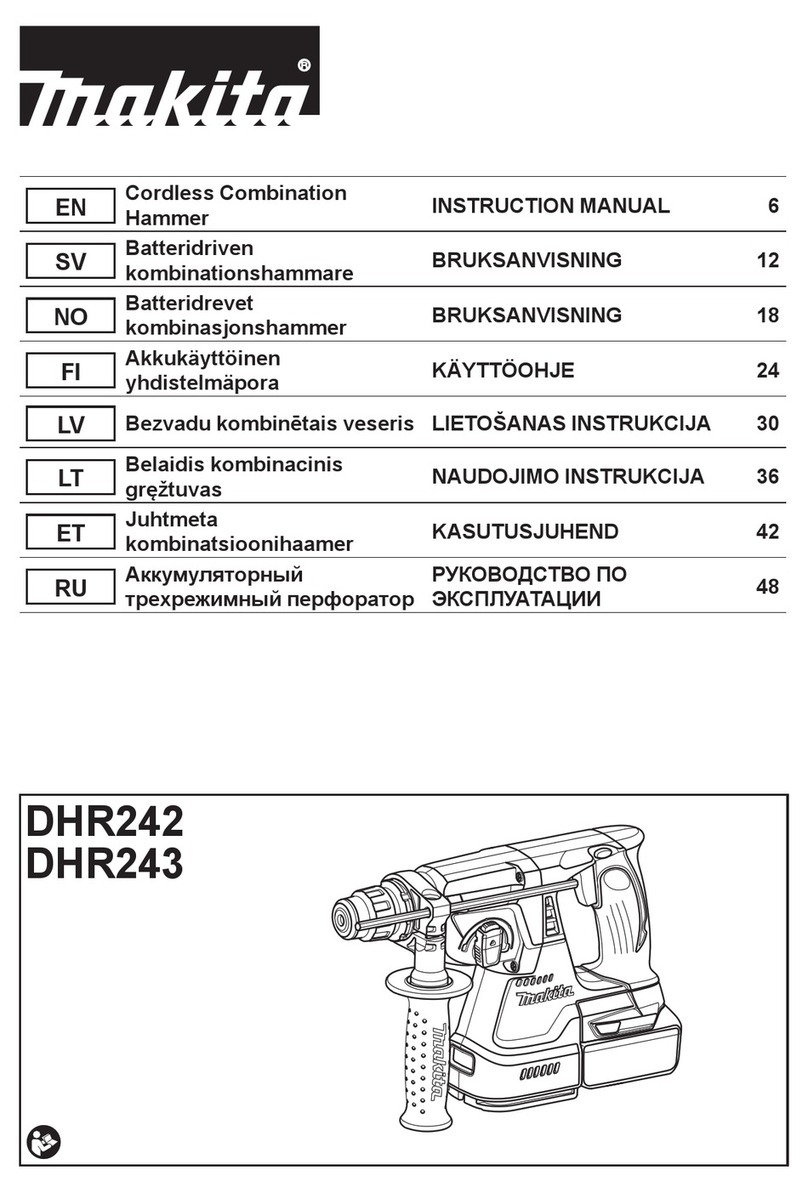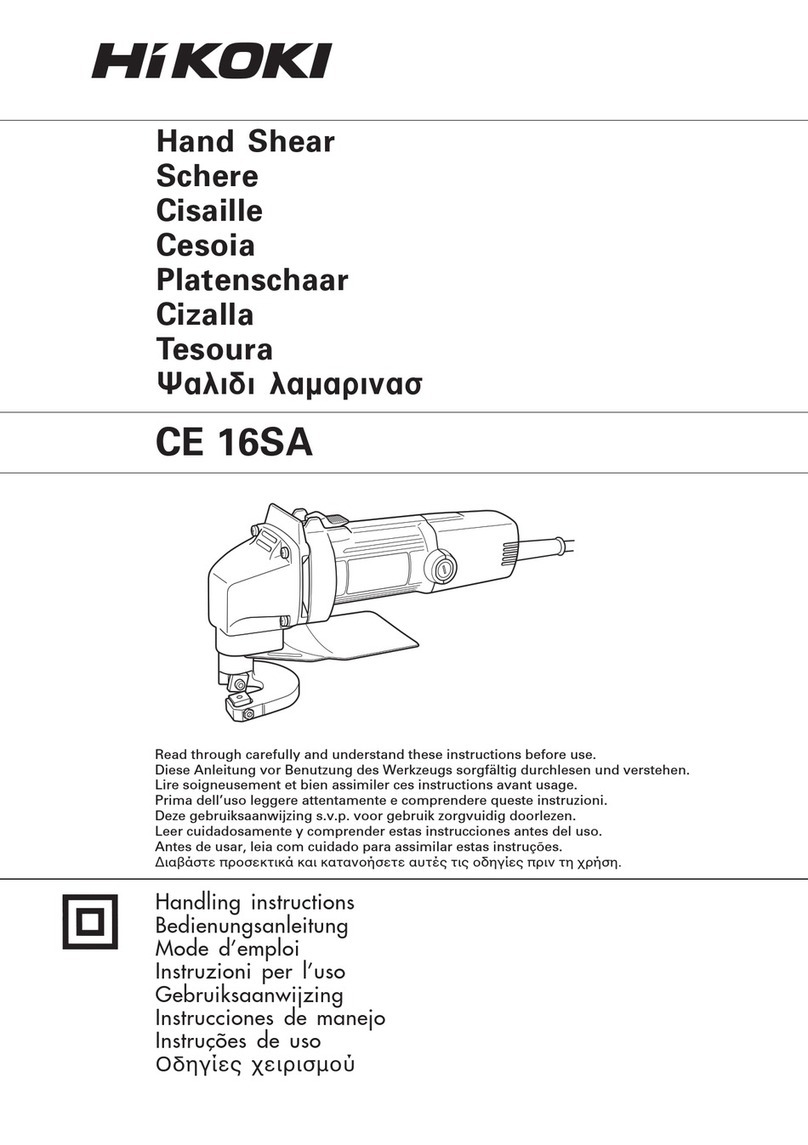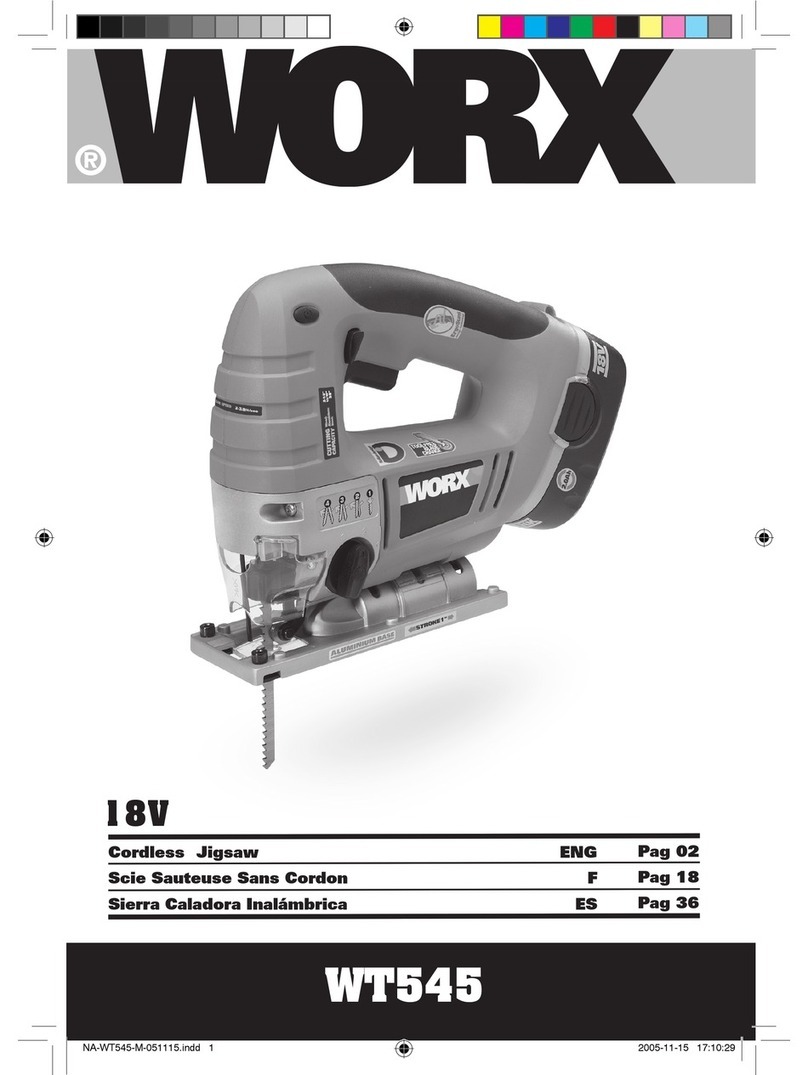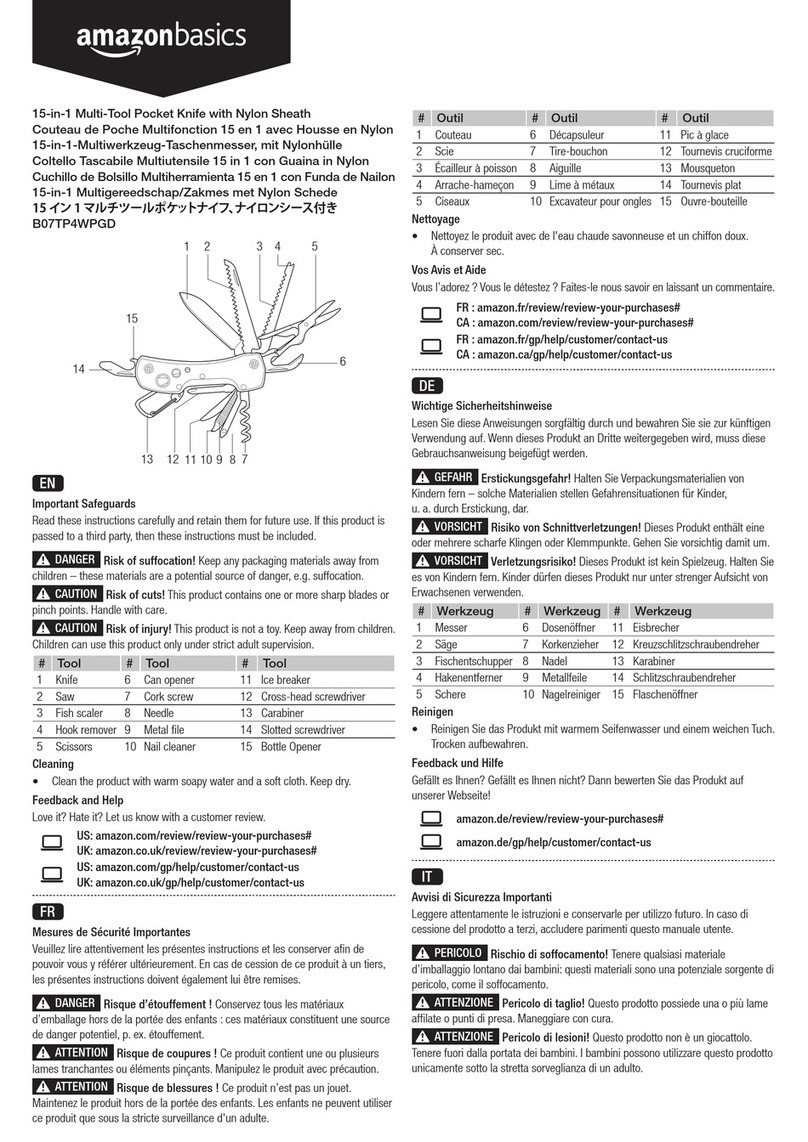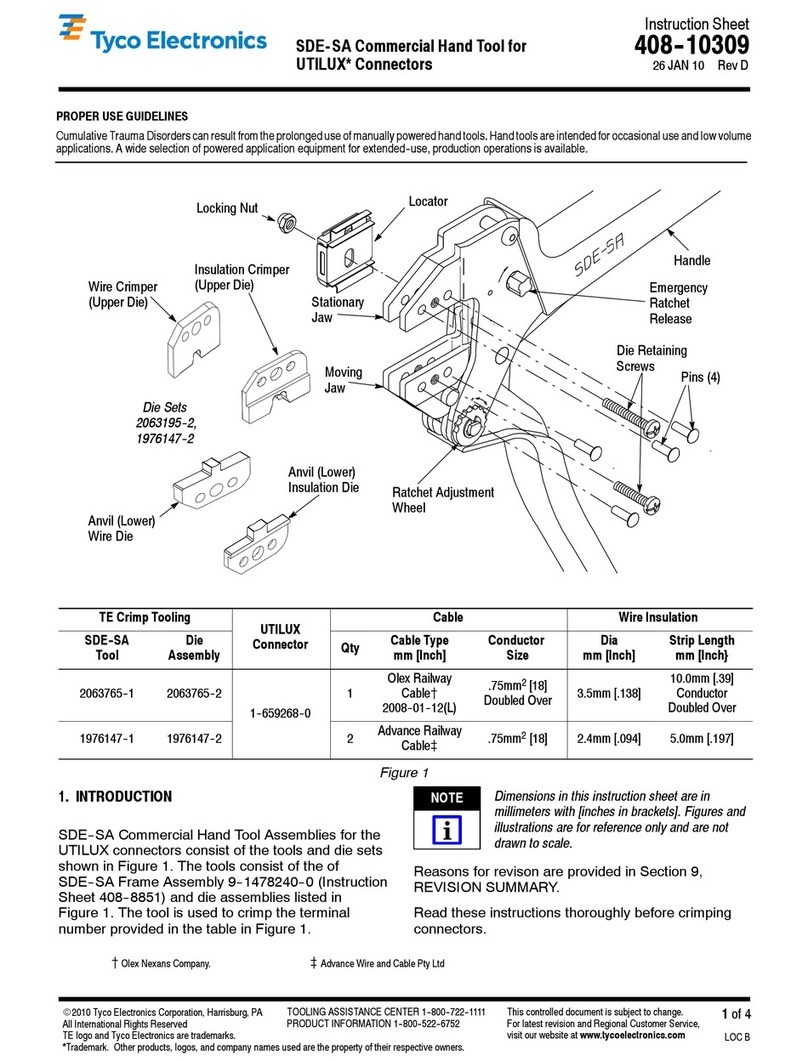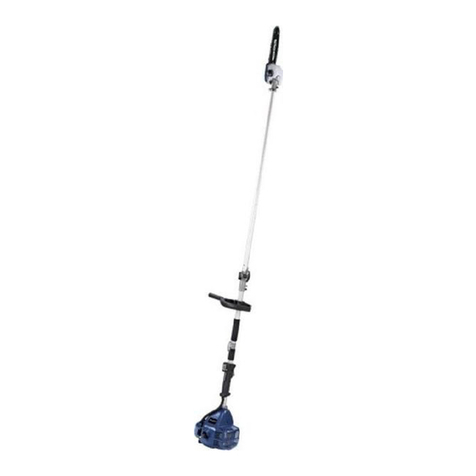Robland T-120 S User manual

1

Contents
CE Homologation 1
Contents 2
Please read first 3
Ordering spare parts 3
Safety and maintenance instructions 3
Danger list 3
User guide 4
Normal and pro ibited use 6
Type of tools 7
Kickback of t e workpiece 8
General dimensions 9
Tec nical data 10
Transportation of t e mac ine 12
Electric connection 12
Starting up t e mac ine 13
Adjustment of t e spindle fence 14
Spindle fence protections 15
Removing spindle fence guide 16
Using t e ring guard 16
Moving t e slide table 17
Clamping system 17
Spindle arbor lock 18
Installation of a feeder 19
Cross-cut fence 19
Independent stops and programmable drawer 19
C angeable spindle 21
Tension of t e belt and c anging t e belt 22
Maintenance 22
Problems and troubles ooting 23
Position of t e limit switc es 23
Readjusting t e engine brake 24
2

Please read first
W en using electrical tools, basic safety precautions s ould always be followed to reduce t e risk of fire, electric
s ock and personal injury.
Read t ese instructions before operating t is product.
If you notice transport damage w ile unpacking, notify your supplier immediately. Do not operate t e mortiser!
Take notice of t e given warnings and advices. T ey serve your safety and t e good working order of t e
mac ine.
T is operating instruction manual is intended for all persons w o carry-out work wit t is tool. It must be read
before using and it must be easily accessible for all persons at all times.
Ordering spare parts
Always mention t e following items on your order:
- type of t e mac ine
- serial number of t e manual
- part number and quantity
- your references: contact name of consignee and adres at place of destination.
For your safety and the operating reliability of the machine:
use Robland parts only.
Safety and maintenance instructions
Woodworking wit mac inery is a pleasant job t at gives lots of satisfaction. Nevert eless it requires constant
attention and care. T erefore, for your own safety, pay attention to t e instructions summarized in t is c apter.
T e mac ine can only be used safely w en t e operator strictly follows t e operating and safety instructions. It is
essential to read t is manual before using t e mac ine to know ow t e mac ine functions and w at t e
limitations are.
- Provide for sufficient space around t e mac ine and a good lig ting of t e works op.
- W en c anging t e tools or performing a maintenance job, t e mac ine as to be disconnected from t e
power supply.
- Knives and tools w ic are not correctly s arpened or in a bad condition not only diminis t e quality of t e
work, but also increase t e risk of accidents.
- Always make sure t at all necessary safety are fitted to t e mac ine and t at t e mac ine is connected to a
dust extraction system.
- Always wear suitable clot ing. Loose or torn clot es are very dangerous w ile operating t e mac ine.
- Keep c ildren away from t e mac ine and t e works op.
- Wearing of earing protection is recommended to prevent noise from damaging your earing.
- W en cutting narrow pieces always use a pus stick. W en damaged replace t e pus stick at once.
- Always use jigs, templates and sawblades adapted to t e work carried out.
- Read t e recommendations to clean t e mac ine carefully. Clean only w en t e mac ine is disconnected from
t e power supply line.
- Make sure all periodic maintenance is done on time. T ese maintenances works s ould only be carried out
wit t e mac ine disconnected from t e main power supply line t us rendering it impossible to start t e
mac ine involuntary.
- Test on a weekly basis t e following electrical components: emergency stop buttons, t e safety switc es and
test if t e mac ine can be started up wit an open door.
- Test on a weekly basis if t e rundown time of t e motor brake does not exceed 10 seconds.
- Keep t is manual w ere t e operator may refer to w enever necessary. T is manual must accompany t e
mac ine w en it is sold, rented or lent to a t ird party.
Danger list
Attention!
Working with woodworking machines can be extremely dangerous if the safety
instructions are not followed.
Therefore use systematically the safety e uipment provided on your machine.
3

User guide
T e following recommendations for safe working procedures are given as an example, on top of all information
and c aracteristics of t is mac ine.
- W en working wit t e mac ine, safety equipment must be used.
- Nevert eless, t e user must also follow t e operating instructions to avoid accidents.
Training of the machine operators
It is absolutely essential t at t e mac ine operator gets enoug training regarding operating and adjusting t e
mac ine. In particular:
- t e risks involved in working wit t e mac ine;
- t e operating principles, t e correct use and adjustments of t e mac ine;
- t e correct c oice of t e tool for eac operation;
- t e safe andling of t e parts to be processed;
- t e position of t e and in relation to t e turning parts;
- storing workpieces safely before and after mac ining t em.
Stability of the machine
In order to use t e mac ine safely, it is essential to place it stable on t e ground.
Adjustment and installation
- Disconnect t e mac ine from its power supply for eac adjustment.
- T e recommendations of t e manufacturer ave to be followed w en adjusting and installing t e tools.
- T e tools ave to be suited to t e mac ine in order to assure a safe and efficient usage.
- T e tools ave to be correctly s arpened and installed wit tool olders t at are carefully balanced.
Handling of tools
W en touc ing t e tool t ere is always t e danger to get urt by cutting edges.
- Be cautious w en unpacking or packing, as well as andling.
- Do not touc tools at t e cutting edges.
- Wear safety gloves w en andling tools in your works op.
- Always put t e tools on a soft support.
- Transport clamping adaptors and tools only in a suitable packing.
Machine handling
- C oose for eac action t e most appropriate safety devices.
- Do not remove c ippings, cuttings, dust and waste of wood or particle board by and.
Installing tools
Special equipment, suc as tool setting gauges, are to be used only w en t e mac ine isn't operating.
Table insert rings ave to be used in order to reduce t e space between t e table and t e spindle s aft to a
minimum.
Adjustment of the fences
Working wit t e spindle fences requires special attention:
- a false or integrated fence s ould be used to minimize t e opening between t e tools and t e fences
- a pus stick s ould be used as often as possible
- a wood pus er s ould be used, toget er wit protection, to pus t e piece manually
- long pieces need to be supported wit roller supports
Direction of rotation and choice of speed
It is very important t at t e c osen tool turns in t e rig t direction.
W en t e piece is presented, t e operator must take care t at t e work piece is fed in t e correct direction at
t e correct c osen speed. T e speed also as to be suited to t e tool on t e mac ine.
Functioning of the machine, choice of safety e uipment and adjustments
Because of t e various tasks t at are carried out by various spindle s afts, spindle olders and cutter blocks,
different types of safety equipment ave to be used. Every operation as to be examined separately and t e
appropriate guarding as to be c osen. T e minimal opening in t e table also depends on t e type of cutter
block, t e diameter of t e knives and t e eig t w ic t e cutter block is adjusted in. In t at way, t e opening is
as narrow as possible and t e work piece no longer can flip over and it t e knives.
Using a power feeder can prevent most serious accidents involving ands. Suc feeders easily are adjusted and
adapted to t e size of t e pieces.
W en no power feeder is used, t e wood pus ers ave to be used, t e orizontal and vertical springs making a
tunnel w ere t e piece can slide in. T is pus er, toget er wit ot er safety equipment, reduces t e gap between
4

t e cutting tool and t e guide fences.
Using the spindle fence when the total length of the machine has to be machined
In most cases a straig t guard fence is used. In t is way t e pieces can be guided in t e angle made by t e table
and t e fence. T e vertical and orizontal pus ers can be placed in suc a way t at a tunnel is formed in w ic
t e first piece can be pus ed. T e second piece is t en used to pus t e first, t e final piece as to be pus ed
forward wit a wood pus er.
Special blocks ave to be used relative to t e dimensions of t e work piece.
W en working t in panels, only t e top of t e spring as to be used, on condition t e t ickness matc es.
On a spindle-moulder, t e distance between t e extremities of t e spindle guard fences must be large enoug to
leave enoug space for t e cutter block. T us t e knives, t e cutter block and t e spindle s aft may be exposed
and t e extremity of t e piece may come in contact wit t e nose of t e exit guard fence.
T ese risks can be avoided by using a false fence between t e spindle guard fences, t us limiting t e opening
between t em.
Using the spindle guard fence when only a part of the piece is machined
W en using t e spindle fence between 2 stops fixed onto t e mac ine table or fences, only a part of t e work
piece is mac ined. By doing so, t e cutting tool starts mac ining t e work piece in t e full section of t e wood
and doesn't start at t e front, t is way t e cutting action is more gradual and less severe, and t e cutting action is
stopped before t e workpiece end is reac ed. T is action is very dangerous and needs special attention and care.
A stop solidly fixed at t e front and back as to be used (see t e example used furt er in t is manual).
A piece may only be guided by and w en it is sufficiently large. In all ot er cases a gauge or a support wit
protection as to be used in order to avoid serious accidents. By means of t e gauge, t e piece can quickly and
precisely be put in place and firmly be eld t ere. A quick clamping system, working wit tumblers or cams, is t e
most practical to old t e piece. W en front and backstops are fixed to t e spindle guard fence or to t e table, a
better control of t e gauge is possible.
Working with the ring guard
W en working wit t e ring guard, a support as to be used, unless a certain process doesn't allow t is, i.e.
w en t e work piece is too large or too small, or w en too difficult to mac ine it cannot be eld in t e support
wit out danger. T e final s ape is obtained by olding t e gauge against a guidance bearing w ic is fixed to t e
spindle w ile t e piece is eld against t e tool. T e gauge can be part of t e support.
Chamfering
W en c amfering a solid support or a tilt adjustable spindle, a guard fence as to be used. A wood-pus er as to
be used for t e final part of t e mac ining.
Working in the direction of the tools
It is extremely dangerous to work in t e direction of t e tools, as t e operator cannot exert force to resist t e
strong movement of t e piece w en t e tool comes into contact. Working in t e direction of t e tools is
forbidden, even w en a support is used.
Other machining
For ot er types of work, e.g. tenoning, special gauges or supports can be used in order to avoid accidents.
T e following safety accessories can be used to elp t e operator during is work:
- supports,
- wood pus ers,
- power feeders,
- rollers,
- stops.
Reasons for tool rupture
Following reasons may lead to a tool rupture:
- grinding cracks or a c ange of t e cutting geometry due to improper s arpening
- jerky movements of t e work piece
- jamming of tool by waste piece
- over eating by friction due to slow feed rate or too low cutting dept , as well as due to dull cutting edges
- too ig feed rate
- too large cutting dept
- insufficient clamping of t e tool
- vibration of t e mac ine.
Operation
- Danger of injuries or crus ing by t e rotating tool
- Do not touc t e rotating tool
5

- Do not slow dawn t e tool by lateral pressure against t e body
- Do not work wit out t e necessary safety guard
Operator’s place at the workpost
For all executions wit t e spindle fence, and for use of t e ring guard fence:
W en tenoning:
Normal and prohibited use
Wit t e T 120 spindle-moulder t e operator can mould and form straig t and curved pieces, and almost any
task in woodworking can be executed in massive wood, wood-based panels and certain plastics.
It is strictly forbidden to process ferrous and non-ferrous materials. It is also forbidden to make c anges to t e
mac ine in order to execute ot er tasks t an t ose described above.
Moulder-shaper
T e s aper assembly is assigned to t e following tasks and equipped wit protective devices. Ot er tasks t an
listed below are t erefore pro ibited.
NORMAL USE
- mould and form straig t and curved pieces on t e vertical spindle;
- s aping of curved work pieces using a ring guard fence;
- mortising, tenoning and panel edge s aping using corresponding safety devices.
PROHIBITED USE
T e following tasks are pro ibited on t e moulder-s aper unit:
- down-cut s aping, i.e. W en feed and tool rotation direction is t e same;
- slotting wit saw blades;
- using tool diameters t at are not adapted to t e spindle by using reducing sleeves;
- using larger tool diameters and ig er speeds t an s own in t e diameter-speed diagram;
- t e use of ferrous and non-ferrous.
REMAINING RISKS
Spindle s apers are one of t e main causes of injuries in woodworking. Nearly all accidents result in and injuries.
Due to contact wit t e rotating tool w en t e work piece is fed by and, a kickback occurs.
T e main danger areas on t e s aper-moulder are:
- t e moving mac ine and tool parts;
6

- t e kickback area.
Always use t e appropriate protection devices and observe t e specific regulations for accident prevention.
Despite t e use of specific protection devices and t e application of t e ygiene and safety instructions, some
risks remain w en working wit t e moulder-s aper:
- risk of accidents in t e insecure area of t e tools;
- risk of wounding w ile replacing tools;
- risk of wounding by t e piece of wood itself;
- crus ing of t e fingers;
- risk of jamming of t e and in t e mac ine, w en using a removable pus er;
- risk of back kicked pieces of wood;
- ealt risk t roug prolonged in alation of particles, especially oak, beac or exotic sorts of wood
- deafness t roug prolonged exposition to noise.
Acoustic levels
T e values given are t e output levels, t ese are not necessarily t e levels on w ic t e operator can work safely.
Alt oug t ere is a link between t e output values and t e safe working levels, it cannot be used in a reliable way
to determine w et er supplementary measures s ould be taken.
Work station
under load
Level continuous
acoustic pressure as
per index A dB(A)
Level acoustic
power
dB(A) (MW)
Max value acoustic
pressure as per index C
(instantaneous) dB
Moulding 84 97 (3,2) <130
Tenoning 86 97 (5) <130
Ear protection is recommended.
Dust extraction
For your ealt and to avoid risk of fire and dust explosion, it is recommended to connect t e mac ine to a dust
extraction system.
A 120mm outlet is provided. It as to be connected to a dust extractor powerful enoug to obtain an airflow of
at least 20 m3/sec (at least 1500 m3/ ) measured at t e outlet of t e mac ine.
Types of tools
Cutter blocks and t e tool olders wit interc angeable blades are frequently used w en moulding.
T e cutter blocks can be made in one piece, t e cutting part being fitted in a body of ard steel, mostly
c romium steel. T e tool olders consist of t e part on w ic t e knives are fitted mec anically. T eir cutting
part is made out of ard metal (HSS) or calcium-carbide (K), as is t e case for t e cutter blocks.
Mortiser
Only use “left” drills on t e mortiser. To avoid vibrations, s ort drills s ould be used as often as possible.
IMPORTANT
For eac tool and for eac diameter, t e correct speed must be c osen.
ickback of the workpiece
Definition
A piece of wood can be rejected in t e direction of rotation of t e tool in a brutal and unexpected manner. T is
can appen w en only a part of t e wood is mac ined, w en feeding direction and rotation direction are
identical, and in several ot er cases.
Causes
T is problem is mainly due to t e design of t e tool body w ic , by its construction, enables t e operator to
take big passes. Ot er causes can also ave an influence:
- number of inserts on t e tool;
- cutting speed;
- inserts sticking out compared to tool body
- type of wood;
- adjustments (e.g. cutting dept ).
Independent of t e above mentioned, following factors ave to be taken in account:
- working conditions: starting to cut in t e middle of a piece of wood, mac ine running, working in t e same
direction as t e rotation sense of t e tool, working wit out stops fixed to t e table or spindle fences.
- speed not adapted to t e type and diameter of tool
7

- maintenance of t e tools: blunt tools, bad installing of t e knives on t e tool- older.
W en t e wood is rejected, it appens sudden and fiercely. A piece of wood wit a square of 50mm and a lengt
of 1 m can be rejected speed t at varies between 20 to 30 m/sec ( i.e. 70 tot 110 km/ ).In t e mentioned case
t e average speed of 100 km/ is already attained after +/- 30 t ousand of a second (0,030) after rejection.
Possible solutions
In all cases:
- use tool- olders; nowadays t ere is a new generation of cutting tools w ic is equipped wit a limited pass.
Alt oug t e rejection of a piece of wood is not ruled out completely, it is nevert eless easier to control by
t e operator.
- c eck w et er t e tools are correctly s arpened,
- respect t e speed of t e tools as to type and diameter. T e sticker on t e mac ine indicates t e optimal
speed to be c osen, taking into account t e type of tool and t e diameter.
- never exceed t e maximum speed t at is indicated on t e tool.
Last but not least: always install various protections w en working wit t e mac ine. T e vertical and orizontal
wood-pus ers must be adjusted so t at t ere is complete freedom of movement to put t e piece of wood into
place and to mac ine it wit out t e risk of ands coming in contact wit t e tool.
8

General dimensions T-120 S – L – P
9

Technical data T-120 S
Table dimensions 1200 x 705 mm
Table eig t 930 mm
Diameter interc angable spindle 50 mm (option: 30 mm / 40 mm / 1 1/4 “)
Spindle leng t 180 mm
Useful spindle leng t 150 mm
Spindle stroke 205 mm
RPM spindle 3000 / 4500 / 6000 / 7000
Standard motor 7,5 HP
Max diameter and eig t table opening 320 x 95 mm
Max diameter tool in spindle fence 250 mm
Net weig t 560 kg
Standard equipment
C angable spindle 50 mm diam
Set of tools
Fences in MDF
7,5 HP motor
Options
Ot er c angeable spindles, diameter on request
10 HP motor
Fences in aluminum
Electrical connection for feeder
10

Technical data T-120 L
Table dimensions 1200 x 705 mm
Table eig t 930 mm
Diameter interc angable spindle 50 mm (option: 30 mm / 40 mm / 1 1/4 “)
Spindle leng t 180 mm
Useful spindle leng t 150 mm
Spindle stroke 205 mm
RPM spindle 3000 / 4500 / 6000 / 7000
Standard motor 7,5 HP
Max diameter and eig t table opening 320 x 95 mm
Max diameter tool in spindle fence 250 mm
Net weig t 655 kg
Total leng t wit table extensions 2600 mm
Total leng t wit telescopic extensions 1315 mm
Leng t telescopic extension front 2600 mm
Standard equipment
C angable spindle 50 mm diam
Set of tools
Fences in MDF
7,5 HP motor
Options
Ot er c angeable spindles, diameter on request
10 HP motor
Fences in aluminum
Electrical connection for feeder
11

Technical data T-120 P
Table dimensions 1200 x 705 mm
Table eig t 930 mm
Diameter interc angable spindle 50 mm (option: 30 mm / 40 mm / 1 1/4 “)
Spindle leng t 180 mm
Useful spindle leng t 150 mm
Spindle stroke 205 mm
RPM spindle 3000 / 4500 / 6000 / 7000
Standard motor 7,5 HP
Max diameter and eig t table opening 320 x 95 mm
Max diameter tool in spindle fence 250 mm
Net weig t 1000 kg
Total weig t of table extensions 2600 mm
Total leng t wit telescopic extension 1315 mm
Leng t telescopic extension front 2600 mm
Standard equipment
C angable spindle 50 mm diam
Set of tools
Fences in MDF
7,5 HP motor
Options
Ot er c angeable spindles, diameter on request
10 HP motor
Fences in aluminum
Electrical connection for feeder
12

Transportation of the machine (fig 1-2)
Depending on t e met od of transport or s ipping, you will retrieve t e mac ine in a crate or on transport
blocks. Remove t e sides of t e crate or cover and slide t e oisting equipment under t e table (fig 1).
T e mac ine can be lifted wit a small crane, or a forklift, but severe s ocks ave to be avoided. Place t e
mac ine on a concrete base, and level t e mac ine in bot directions.
T e packing itself, made of fire plates and wooden beams, can easily be recycled. Take t e sides off t e crates and
remove t e cardboard and parts fastened to t e bottom of t e crate. Take t e mac ine off t e pallet by means of
lever bands.
For will pick up, t e assembled mac ine is mounted securely on transport blocks.
T e table surface and all exposed parts are covered wit a protective plastic film.
Avoid any impact w en unloading t e mac ine and never pull t e worktable.
Mac ine on pallet: move t e mac ine on level ground using a pallet jack as s own in t e drawing.
Use a wooden ramp made of t ick board and wooden beams and secure t e ramp to t e pallet in order to avoid
slipping of t e ramp. Never try t e mac ine on rollers w en it's on an incline. Once t e mac ine is on ground
level, move it wit a pallet jack or forklift.
Attention!
When uploading the machine with a forklift, please raise the spindle arbor
completely.
Fig 1 Fig 2
Attention!
Make sure t e loading capacity is sufficient. Place t e lever bands in a way t ey don't put pressure on t e tables.
Lift t e mac ine a few centimeters to remove t e bottom of t e crate.
Start up
Make sure t e mac ine was not damaged during transportation or w ilst uploading. Position t e mac ine in a
stable position on solid underground and make sure t ere is enoug space around t e mac ine to use safely.
Electrical connection (fig 3)
T e electrical connection as to be carried out by a qualified electrician w o is able to calculate t e required
wire section and amperage of t e fuses.
- confirm t at t e main voltage of your mac ine corresponds wit t e voltage in your works op;
- t e open t e electrical components box at t e back of t e mac ine (fig 3);
- connect t e 3 p ases to t e terminals marked L1, L2, L3 (fig 4);
- if t ere is a neutral conductor (blue) it as to be connected to t e terminal N;
- connect t e eart (green + yellow) to t e terminal marked wit t e eart symbol;
- make sure t e spindle runs free prior to starting up t e motor.
C eck t e direction of rotation of t e motor. T is test as to be carried out on t e spindle-motor at 3000 RPM.
T e direction of rotation as to be, seen from above, anticlockwise. S ould t e direction of rotation be incorrect,
t e wires L1 and L2 ave to be exc anged.
13

Attention
- First, make sure t at t e spindle runs free and all necessary protective equipment is in place before starting up.
- S ould t e direction of rotation be incorrect, t e wires L1 and L2 ave to be exc anged. For safety t is as to
be carried out wit out tools on t e spindle.
Fig 3
Power supply
Electrical potential 5,5 kW – option 7,5 kW
Wire section connection wires 2,5mm²
Nominal current 11 Amp / 5,5 kW – 15 Amp / 7,5 kW
Connection 380 V tri + eart
Frequency 50 HZ
Starting up the machine (fig 4 – 5 -6 – 7)
- Turn on t e main switc (fig 4.1), w ic can be padlocked, on “1” to put t e mac ine under tension.
- Make sure t e brake release switc (fig 6.2) is in position”0). W en t e green indicator lig ts up (fig 6.3) t e
mac ine cannot be started up.
- Put t e star-delta switc (fig 5.4) on “star” and pus t e start button (fig 5.5 / fig 7.5). T e motor starts up in
“star”, but as to be switc ed to “delta” after about 10 seconds.
- T e motor can be switc ed off by t e “stop” button (fig 5.6 / fig 7.6) or by t e “emergency stop” button (fig 5.7
/ fig 7.7).
Fig 4 Fig 5
Attention
- W en t e mac ine is stopped, t e motor automatically brakes.
- It is not possible to start t e mac ine w ile t e access door is opened or w en t e brake release switc (fig
6.2) is on “1” and t e yellow indicator lig ts up.
14

- It is not possible to start t e mac ine w en t e spindle lock (fig 16 – 17) is functioning.
- T e control lig ts (fig 6.9) indicate t e speed of t e spindle.
- T e switc (fig 6.10) determines electric up or down movement of t e spindle (option) and functions only
w en t e main motor is switc ed off.
- W en using automatic star delta (fig 6.8) t e direction of t e rotation is determined by t e switc .
- To prevent t e mac ine from turning t e wrong direction t ere is an additional security feature. S ould t e
mac ine turn in t e opposite direction a yellow indicator lig ts up(fig 4.11 / fig 6.11).
Fig 6 Fig 7
Adjustment of the spindle fence (fig 8-9)
Basic version (fig 8)
- T e body of t e spindle fence is attac ed to t e table wit 2 bars (fig 8.1).
- T e infeed fence can be arranged micrometric relative to t e body of t e fence by a knurled screw (fig 8.3).
- t e position is locked by a knob (fig 8.2) on t e side of t e spindle fence.
Fig 8
Pro version
- T e body of t e spindle fence is located on a guide plate and moves on linear guides.
- T is plate is attac ed to t e table by 2 locking pins (fig 9.1).
- T e spindle fence is moved by using a and-w eel (fig 9.2).
- Use t e ot er and-w eel to control t e infeed fence (fig 9.3).
- Use t e locking screw (fig 9.4) to lock t e infeed guide in position.
- T e body of t e spindle fence is attac ed to t e table wit a bar (fig 9.5).
15

Fig 9
Spindle fence protections (fig 10)
Adjustments
- Adjust t e fences as close as possible to t e tools and adjust t e orizontal wood-pus er (fig 10.2) according to
t e widt of t e piece of wood. Adjust t e vertical wood-pus er (fig 10.3) according to t e eig t of t e piece of
wood t at is mac ined, but make sure t e wood is placed as close as possible to t e fences.
- W en t e protection is placed correctly, t e wood-pus ers exert enoug pressure and t e wood can be put
put against t e fences w ile it is supported between t e clamps.
- It is advised to use a pus -stick w ile working wit t e spindle protection.
- If only part of t e wood is mac ined (see “operating instructions”) it is easier to pus t e piece of wood against
t e stop w en t e orizontal wood-pus er screen is turned away.
- To remove t e entire system from t e vertical axle, it is needed to remove t e knob.
Fig 10
16

Removing the spindle fence guide (fig 11)
- W en t e mac ine is equipped wit a lift arm (option) t e spindle fence guide can be removed easily.
- Move t e protection forward on t e guide plate and place t e infeed guide backwards as far as possible.
Proceed to slide t e superstructure forward to disassemble t e guides.
Important
- Start by unscrewing t e 2 barring pens (fig 11.2) t at old t e guiding plate w en t e lift arm is mounted.
- T en proceed to screw t e lift arm (fig 11.2) onto t e lifting block (fig 11.3).
- Once t e spindle fence is completely lifted, t e w ole system can be pivoted away.
- To post t e system back, just pus t e spindle fence back into place. Repair points are provided on t e guiding
plate.
Fig 11
Using the ring guard fence (fig 12)
Attention
It is obligatory to use a ring guard fence made for tools wit a maximal diameter of 180 mm.
Description: Ring guard fence for spindle diameter 50 mm.
1) Body spindle protection
2) Guidance template
3) Wood guidance
4) Woodpresser – and protection
5) Adjustmend button
6) Auto release andle
7) Dust extraction outlet
8) Locking knob
Fig 12
Positioning
T e ring guard fence is into 2 oles of t e spindle table. Take care bot positioning parts are well introduced into
t e table.
Adjustments
- Adjust t e eig t of t e ring guard fence in function of t e place of t e tool and t e t ickness of t e wood. Fix
wit an Allen key.
- Adjust t e eig t of t e pus er (4) in function of t e t ickness of t e wood – a slig t pressure of t e pus er on
17

t e wood is desirable. Fix wit t e Allen key.
- Horizontally: fix wit t e 2 andles (6) to protect maximally t e working piece following t e diameter of t e
tool.
After c ecking t e diameter of t e tool, t e pass as to be adjusted wit extreme precission by using t e knob
(5) at t e back of t e support. Turn t is knob anticlockwise to increase t e pass, t en fix on t e support.
Operation
- Usually t e wood is treated wit t e tool mounted underneat t e guidance template. Prior to starting up,
c eck t e blocking of all andles.
- T e wood is guided along t e straig t part of t e template. Treatment is carried out progressively, wit a
maximum on t e index of t e template (t at index is visible t roug out t e orizontal pus er). T e wood
guidance (3), connected to t e fence, replaces t e gauge w en calibrating wit a bearing stop. T e operator is
obliged to use t e guidance (3) w ic is delivered wit t e fence. It is advisable to adjust t e wood pus er (4) on
t e wood and to put on maximum frontal cover.
Moving the sliding table (fig 13)
T e table extension for profiling and calibrating is mounted on t e sliding table and is on t e same level as t e
spindle table.
In order to protect t e operator w en tenoning, t ere is a supplementary emergency stop on t e support of t e
sliding table. T e tenoning table (fig 13.4) slides over t e spindle table and can be operated by loosening t e
andle (fig 13.3) 1/2 turn.
Next t e tenoning table as to be placed as close as possible to t e tool and blocked wit t e andle (fig 13.3).
T e w ole system can be locked by means of t e knob (fig 13.2).
T e support legs of t e sliding table carriage can be adjusted in eig t after setting t e course of t e sliding
table.
Unlock t e bolt w ic olds t e adjustment pad and put it on t e floor and lock t e bolt.
By means of bot andles (fig 13.12), t e first at t e front of t e sliding table, t e second at t e back, t e sliding
table bars can be moved to t e front and back to alter t e course of t e sliding table. T ese andles ave to be
loosened 1/2 turn to allow t e sliding table to position t e sliding carriage in function of t e piece of wood to
be mac ined.
Clamping system (fig 14)
Loosen t e clamping andles (fig 14.1) in order to free t e orizontal bridge to adjust in eig t of t e wood-
pus er by turning t e knob (fig 14.2).
After adjusting t e eig t t e clamping andles must be well tig tened. T e wood, or t e piece to be mac ined, is
pus ed downward wit t e eccentric pus er. To do t is, press down t e andle (fig 14.3).
In order to use t e table extension w en working wit t e spindle fence, t e elbow protection as to be tilted
away. Lift t e protection in order to loosen it from t e lock, t en pivot it 90 degrees and put it back on t e bolt
wit t e opening in t e protection. Now t e elbow-protection will not inder w en tenoning.
Fig 13 Fig 14
18

Spindle arbor lock (fig 15-17)
It is mandatory to wait until t e spindle as come to a complete alt before locking t e spindle arbor (see
warning on t e mac ine).
- Put t e brake release switc (fig 15.2) on “1” in order to release t e spindle arbor from t e brake motor.
- T en t e andle as to pus ed downward into t e stop groove on t e frame (B).
- Turn t e spindle manually to bring t e spindle in locking position (fig 17. A-B).
- Two electrical contacts prevent t e motor from being started w en t e spindle or anot er tool is being
replaced.
- To get t e mac ine ready for use, it is important to c eck if t e andle is pointing up (fig 16. A) and t e brake
release switc is on “0” (fig 15.2).
-T e braking motor on t e mac ine is automatically put into action w en t e emergency stop (fig 5.7 / fig 7.7) or
t e stop button (fig 5.6 / fig7.6) is pus ed.
Installation of a feeder
T e feeder can be used as protection w en tenoning and is often t e best protection on t e mac ines. Feeders
can easily be adjusted to t e size of pieces to be mac ined.
An electrical connection for t e feeder can be delivered in option. It is a t ermo-magnet w ic can be installed
inside t e electrical panel, wit a CEE connection on t e outside.
T e feeder as to be connected to t e power supply. W en t e tool- older is stopped, at t e same time t e
feeder is automatically stopped.
Fig 15 Fig 16
Fig 17
19

Installation of a feeder
T e feeder can be used as protection w en tenoning and is often t e best protection on t ese mac ines. Suc
feeders can easily be adjusted to t e size of pieces to be mac ined.
An electrical connection to t e feeder can be provided in option. It is a t ermos-magnet t at can be installed
inside t e electrical panel, wit a CEE connection plug on t e outside of t e mac ine.
T e feeder as t en simply to be connected to t e power supply. W en t e tool older stops, t e feeder will be
stopped automatically.
Cross-cut fence (fig 19-21)
In order to compensate t e t ickness of t e stops and to avoid splinters, t e cross-cut fence is equipped wit a
wooden splinter protection (fig 19.1).
T e splinter protection can be moved front and back by loosening t e andle (fig 19.3) and t us releasing t e
clamp (fig 19.4). T e ruler can be moved by loosening t e screw (fig 19.2).
To move t e cross-cut fence forward or backward compared to t e spindle, bot bolts (fig 21.A- ave to be
loosened.
To make positive and negative cuts wit t e fence on t e sliding table, t e axis (fig 21.1) and t e andle under t e
spindle fence (fig 20.2) need to be unlocked.
T e stop on t e fence as to be pus ed down to overrule it (fig 20.1).
T e angle of inclination can be read at t e front of t e tenoning table on t e index in t e table (fig 21.2).
To put t e telescopic cross cut fence in a rig t angle to t e direction of t e sliding table, t e fence as to be
pus ed against t e stop (fig 20.1). T en t e vertical wood-pus er (fig 21.1) and t e andle (fig 20.2) need to be
tig tened again.
Independent stops and programmable
drawer (fig 22-24)
T e cross-cut fence is equipped wit 2 independent stops. T e stop must be placed on t e cross-cut fence to
execute t e work at and. By turning t e locking nut (fig 22.1) 1/2 turn, t e body of t e stop is pus ed against
t e fence and a possible tolerance between stop and fence is avoided.
T en t e locking nut ast to be tig tened to fix t e stop to t e cross-cut fence (fig 22.2).
T e measures can be read directly t roug t e magnifying glass on t e index.
T e wood to be mac ined as to be pus ed against t e stops (fig 22.3 / fig 22.4) before fixing wit t e eccentric
wood pus er.
W en t e locking nut is not fixed (always 1/2 turn in one direction), t ere t e risk of aving a difference between
t e splinter protection and t e stop ( aving t e same t ickness), t us forming a false angle, or t at t e wood is
not in line against t e stop and splinter protection.
In order to use t e telescopic fence t e knob (fig 24.1) as to be loosened and t e fence as to be pulled
backward. T e measures are read on t e magnifying glass (fig 24.2).
To use t e drawer (fig 23) please refer to above.
Fig 19 Fig 20
20
This manual suits for next models
2
Table of contents
Languages:
Other Robland Power Tools manuals

